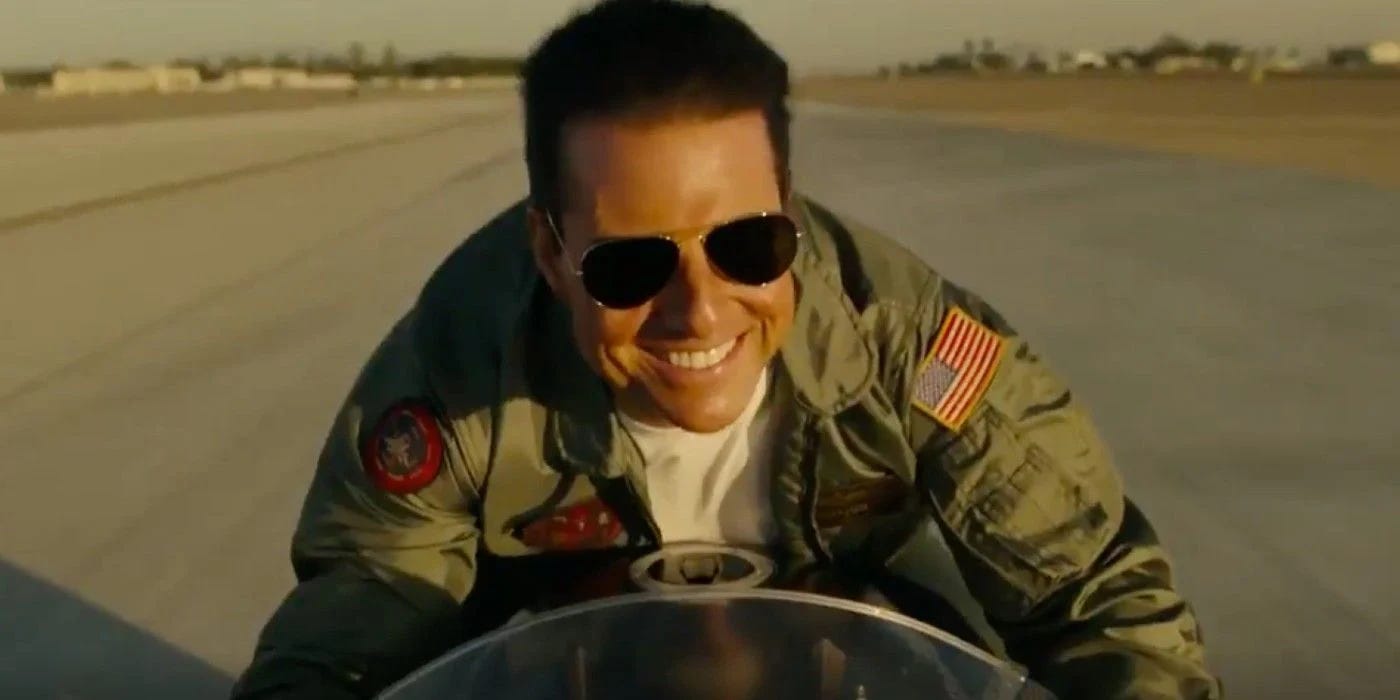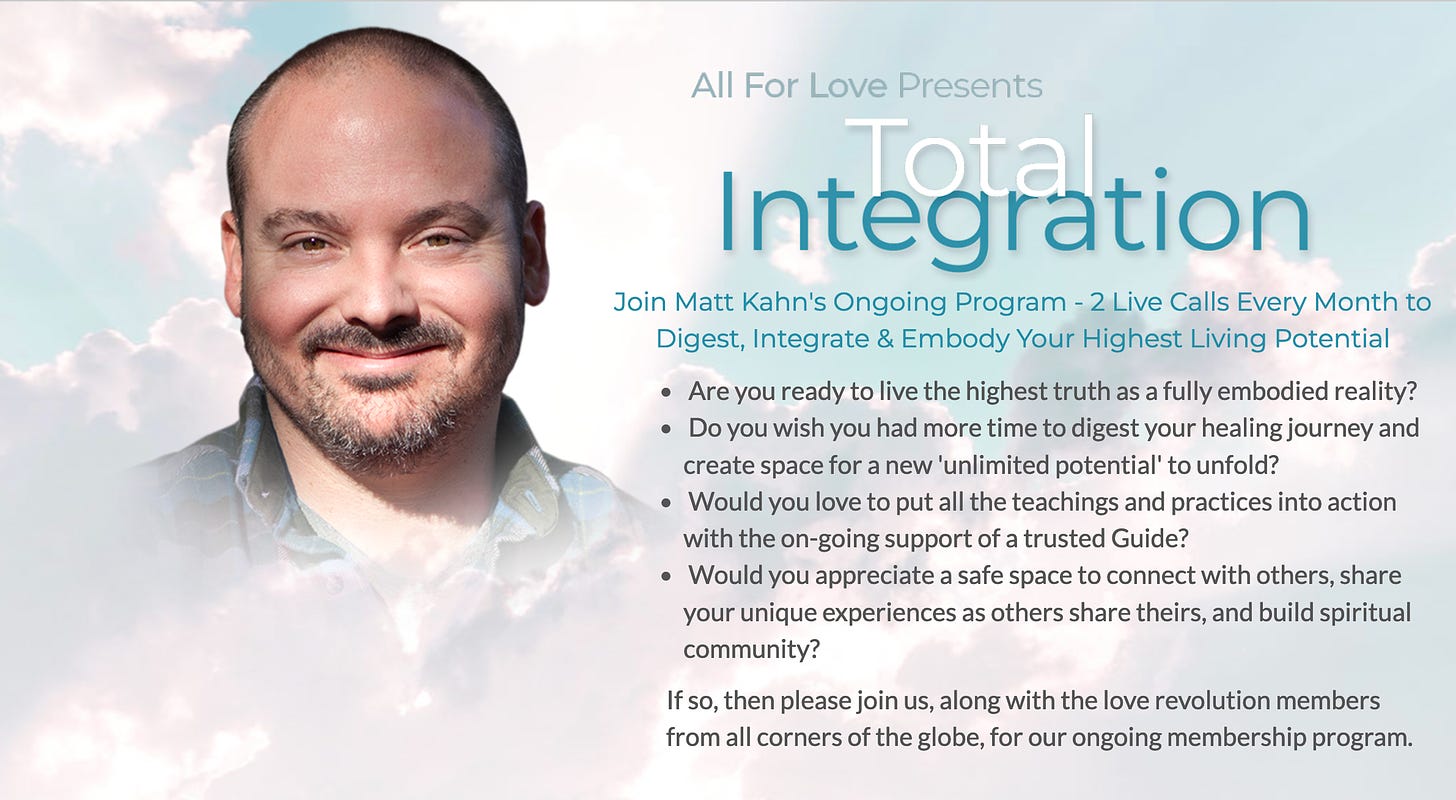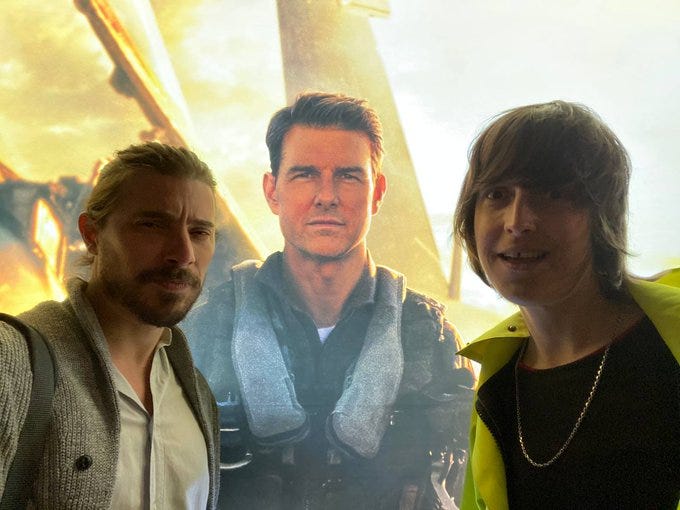This week, I wanted to write about the hot topic of ‘the multiverse’ but Everything Everywhere All at Once was sold out, so I ended up going to see Top Gun: Maverick on a two-for-one deal with fellow cheapskate, Ellie.
I’d read Anthony Lane's review in the New Yorker, so knew the correct level of incredulity to adopt when viewing. And we enjoyed it a lot, surrounded by people laughing at its endearing corniness.
It helped that we were in the front row on reclining seats, virtually horizontal, watching it on the largest screen in the cinema. Even if the film had been rotten, it was a delight to be immersed in speed, peril, and the ageless1 candour of Tom Cruise's face displayed as big as a house.
Cruise’s character, Maverick, is trapped inside a man-child’s fantasy of the good life. He rides motorbikes, flies jets, and is effortlessly charming with women. But what struck me most is that he lives beyond cringe. Even when he is being humiliated in a bar scene, he has a wise smile on his face. As well as being fit, handsome, potent, the best of the best at his job, he is, somehow, no longer affected by embarrassment.
The only event that still gnaws at him and prevents him from moving on, is when his wingman died in the original Top Gun. Fortunately for him, he’s handed one last job: training pilots for an important world-saving mission that, coincidentally, might help resolve his trauma and live a life of total integration.
I’ve had the phrase ‘total integration’ in my head for the last few weeks. I was even half-thinking of renaming this blog Total Integration, because of the way that it has encouraged me to seek out unresolved questions and try answering them. Unfortunately, this nebulous man got there first and turned Total Integration into his own brand of spiritual therapy.
For me, however, total integration is accepting all that has happened, not seeking to escape or deny. It is that moment where you don’t pass judgment on your mistakes but treat them as learning experiences. No matter what occurred in the past, you own it entirely: all the guilt, all the things you've done, the nasty things you said in anger. You live with the truth and from this truth you hope to make better decisions in the future.
Most people when they have an intrusive thought will try to distract themselves. Just forget it, move on. It is hard to sit there and be with the thought. But this is what you have to do when you undertake a ten-day silent meditation retreat, like those taught by SN Goenka, which feel more akin to psychoanalysis than Buddhism.
Here’s how it works. After three days honing your attention, you spend the next six days doing a body scan in order to relieve stored traumas. Memories of unresolved incidents pop up in the mind, but because you're in a relaxed setting you can make peace with them. Awakening, according to Vipassana, is when all traumas are resolved and all aspects of yourself integrated.
Whenever I have a cringeworthy memory, I try to think of this meditation retreat and what I learned there. I sit with the feeling and allow it to stay there without resistance. But I wonder if it is enough. Apparently, in Alcoholics Anonymous’s 12 steps, you have to actively seek out those you hurt and apologise directly. I sometimes wonder what it would be like to turn up decades later at the house of someone you wronged:
Hi, it's me, the kid who called you speccy when we were nine. Turns out, I wear glasses too! Well, anyway, just wanted to apologise for the namecalling. What? You don't remember. You don't remember being called speccy? Good. Well, anyway, got to go. I'm on a tour of people I've wronged in my life. You're number 8. Only 683 left!
That's how I imagine it would go.
Maybe all spiritual practices aim for something similar, whether it is silent prayer, Catholic confession, or the ‘processing’ that is apparently central to Scientology.
Time is a flat circle. An event from 20 years ago can feel, to me, as real as something that happened yesterday. It’s not good; especially because it can lead you to endlessly pick over the past.
Nonetheless, I think it is still worth integrating. While I was writing this, I came across a piece called Cringe Equanimity, which is basically the same thing I’ve been talking about. In this article, every cringe is an opportunity to achieve equanimity.
Cringe is a prison. It is the prison of being reasonable. When we cringe at ourselves, this is the signal that we’ve stepped across the boundaries of our inner enclosures. Less cringing, less enclosure. When we cringe at others, this is the signal that they remind us of the attributes we reject in ourselves. Less cringing, less rejection.
It feels good to say this, just as it feels good to watch Tom Cruise achieve total integration by the end of Top Gun: Maverick. By the laws of physics, Tom Cruise will age and die, no matter how many thetans flow in his bloodstream. Until then, he is going to run and run, living out his fantasy so that we can avoid our reality.
As a part of putting all these ideas into practice, I present a re-purposed podcast I made with my friend, S, in 2012. It was never released at the time because I found it too cringeworthy, but now I think it’s ready to be integrated.
People are obsessed with the Cruise’s youthfulness. At a party V. said she thought it was incredible how he looked aged 66—even doing his own stunts. Well, Cruise is actually 59 and Top Gun: Maverick was made in 2018 when he was 55, after being delayed again and again, because of the pandemic and, especially, because Tom Cruise is so committed to the art of cinema rather than just putting films on streaming services. But his apppearance is still pretty impressive and a good advertisment for the Scientologist lifestyle.









